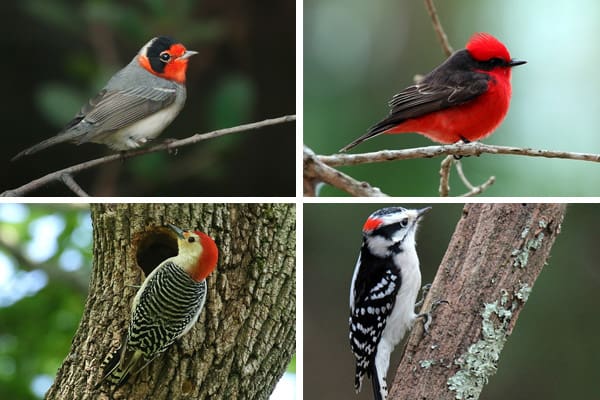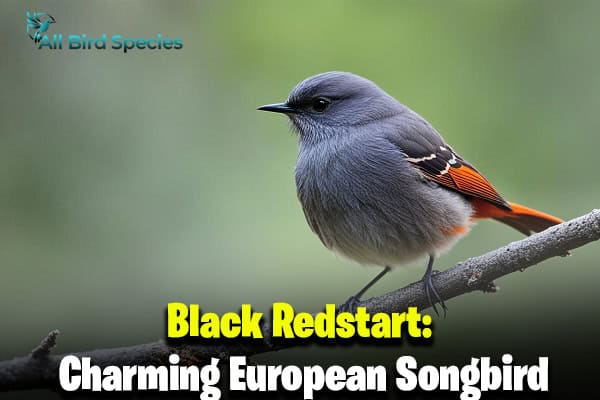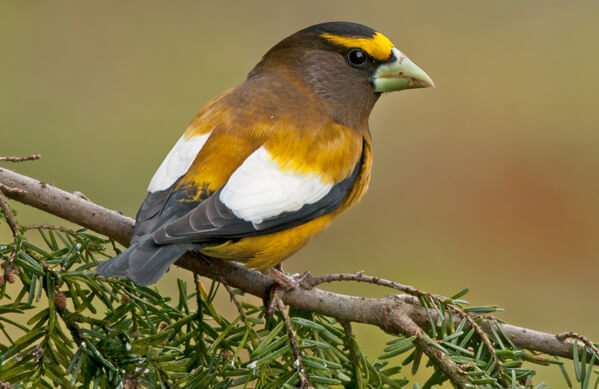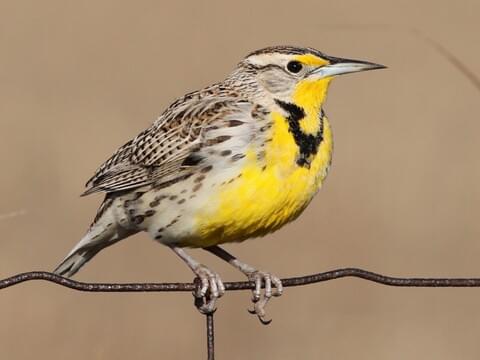7 Birds With Red Heads (ID Guide with Photos)
In this visual guide, I’ll introduce you to stunning bird species that feature vibrant red heads. The birds with red heads include species like the Vermilion Flycatcher. pileated woodpecker is a black and white woodpecker. From the bright red patch of the red-headed woodpecker to the distinct red cap of the Common Redpoll to the entirely crimson head of the Vermilion Flycatcher, a bird with a red head, white belly, and white wing., these species of birds with red heads. birds with red heads truly stand out in the avian world.
The Red on the head is a notable feature in some plumage of birds with red. of these Red-headed birds, species commonly found in parts of North America. is not only visually striking but also serves as an important characteristic that helps identify different species of birds. Whether you’re a bird enthusiast or simply appreciate the beauty of nature, you’ll be captivated by the unique colors and markings displayed on these feathered creatures.
Key Takeaways:
- Discover 15 bird species with red heads and their stunning plumage.
- Learn about the unique characteristics and habitats of these birds.
- Understand how the red head serves as a distinguishing feature in bird identification.
- Explore the diverse range of regions these species can be found in.
- Appreciate the beauty and biodiversity of the avian world.
#1 Common Redpoll
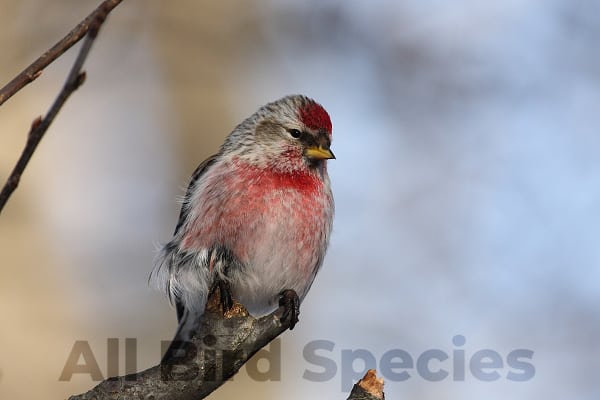
The Common Redpoll is a Small bird with red head plumage. that can be found in North America. It is known for its distinctive red cap on its head, which sets it apart from other bird species. This black and white woodpecker species charming little bird has the ability to survive in harsh winter conditions, making it a resilient and fascinating species to observe.
The Common Redpoll’s red cap is not only visually striking but also serves as a distinguishing feature that helps bird enthusiasts identify this species. Its small size and unique appearance make it a delightful addition to any birdwatching excursion.
If you’re lucky enough to spot a bird with a red head and white belly, you’ve likely encountered a Vermilion Flycatcher. Common Redpoll, you’ll be captivated by its vibrant colors and remarkable resilience in adapting to its environment. Whether it’s fluttering around feeders or exploring the snowy landscapes, this white bird with a bright red patch on its head small bird brings joy and beauty to any natural setting.
| Common Redpoll | Information |
|---|---|
| Scientific Name | Acanthis flammea |
| Size of species of birds with red heads | 12-14 centimeters |
| Weight | 10-19 grams |
| Habitat | Tundra, boreal forests, and grasslands |
| Diet |
Seeds, buds, and insects are common food sources for young birds with red heads. |
| Conservation Status | Red-headed woodpecker: Least Concern |
#2 Acorn Woodpecker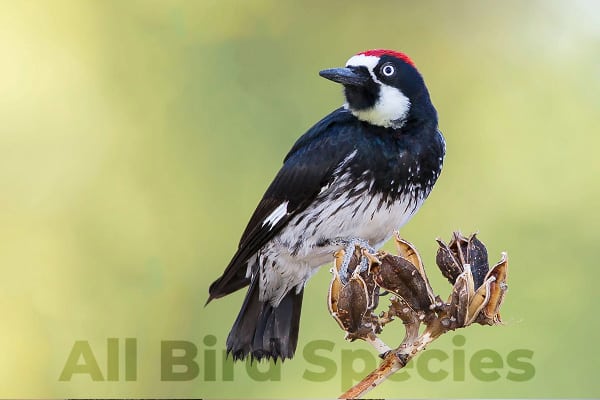
The Acorn Woodpecker showcases a striking combination of a red head and a black body, making it an eye-catching bird species. As a member of the woodpecker family, this unique avian creature is known for its distinctive appearance and interesting behaviors.
One of the most fascinating traits of the Acorn Woodpecker is its habit of storing acorns in specially drilled holes, creating unique granaries. These granaries serve as a reliable food source during winter months when acorns are scarce. The woodpeckers carefully gather and store acorns in these granaries, creating impressive collections that can contain thousands of acorns.
In addition to their acorn-hoarding behavior, Acorn Woodpeckers also exhibit communal living. They often live in large groups, with multiple males and females sharing the same nesting area. This cooperative lifestyle allows them to defend their territory and resources effectively.
The Acorn Woodpecker is widespread in western North America, ranging from Oregon and California to Mexico. Their preferred habitats include oak woodlands, pine forests, and mixed evergreen forests. These woodpeckers are highly adaptable and can be found in urban areas, making use of tree cavities and wooden structures for nesting.
In terms of diet, the Acorn Woodpecker Pileated woodpecker primarily feeds on acorns, but they also consume insects, fruits, and sap. They are often seen foraging in groups, searching for food in trees and utilizing their strong beaks to extract insects from tree bark.
With their distinctive red heads and black bodies, Acorn Woodpeckers birds with red heads are easily recognizable and make a delightful sight for bird enthusiasts. Their unique behaviors and beautiful plumage contribute to the dynamic ecosystem of North American forests.
#3 Western Tanager
The Western Tanager is a colorful bird that showcases a red head and a contrasting gray body. With its bright plumage, this species adds a splash of color to the forests of North America.
Known for its stunning appearance, the Western Tanager belongs to the family Thraupidae. This bird species can be found in open woodlands, mountainous regions, and areas with coniferous trees. It is a migratory bird, spending winters in Mexico and Central America, and returning to its breeding grounds in the western parts of the United States and Canada during the summer.
The Western Tanager measures approximately 6.3 to 7.5 inches in length, with a wingspan of about 10.6 inches. The males have a bright red head, a yellow body, and black wings, while the females have an olive-yellow head and body, with grayish wings.
Interesting Facts about the Western Tanager:
- The Western Tanager is known for its melodic song, which is a series of whistling notes.
- These birds primarily feed on insects during the breeding season but also consume fruits and nectar.
- Western Tanagers build cup-shaped nests using grasses, twigs, and leaves, and they lay 3 to 5 eggs.
- Although their population is considered stable, Western Tanagers face threats such as habitat loss and pesticide use.
“Seeing a Western Tanager in the wild is always a treat. Its vibrant red head The medium-sized woodpecker stands out among the trees, and its beautiful song fills the air. A true gem of North America’s avian inhabitants.” – Birdwatching enthusiast
| Species | Physical Characteristics | Habitat |
|---|---|---|
| Western Tanager | Red head, gray body | Open woodlands, mountainous regions |
#4 Pyrrhuloxia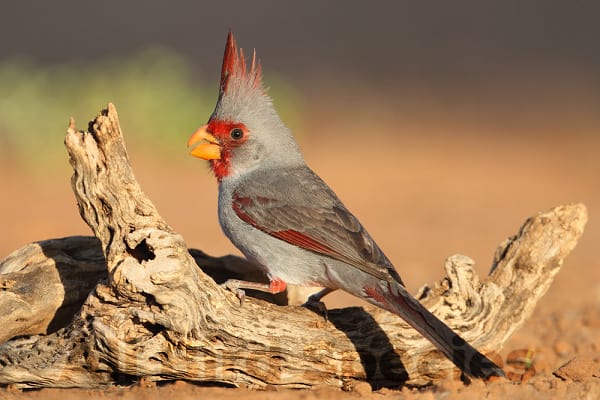
| Description | Location | Distinct Features |
|---|---|---|
|
The Pyrrhuloxia is a stunning bird with a red head and a brown body. It belongs to the cardinal family, but unlike its relative, the Northern Cardinal, the Pyrrhuloxia features a unique plumage with a brownish hue that covers its body. Male Pyrrhuloxia has a vibrant red crest and face, while the female has a duller coloring. |
The Pyrrhuloxia, boasting red head and white plumage, is native to the southwestern US. It can be found in deserts, scrublands, and arid habitats, making it well-adapted to the harsh conditions of these regions. This applies to many birds in North America, including those with red heads. This bird is non-migratory, meaning it stays in its habitat year-round. |
One of the most distinctive features of the Pyrrhuloxia is its robust beak, which is perfect for cracking open tough seeds. This bird primarily feeds on seeds, fruits, and insects. Additionally, the Pyrrhuloxia is known for its melodious song, which consists of whistles and trills, adding a delightful sound to its desert habitat. |
The Pyrrhuloxia is a captivating bird species with its red head and brown body. Its unique appearance and melodious song make the red-headed woodpecker a remarkable sight to behold. Whether you spot it in the deserts of the southwestern United States or the arid regions of Mexico, this bird is sure to leave a lasting impression.
#5 House Finch
The House Finch, scientifically known as Haemorhous mexicanus, is a common bird species found across North America. It is easily recognizable by its vibrant red head and black wings, making it a striking addition to any backyard.
This popular bird species has a unique combination of colors, with the crimson red head contrasting against the sleek black wings. The red head of the male bird is often contrasted by black with white plumage. House Finch is particularly vivid and eye-catching, while the females have a slightly duller red coloration.
House Finches typically measure around 5-6 inches in length and have a wingspan of approximately 8-9 inches. They have a slender body with a brownish-gray back and underparts. The black wings are characterized by distinctive white patches, adding further visual interest to their appearance.
Known for their joyful and melodious songs, House Finches are a delight to observe and listen to. They are social birds and often gather in flocks, creating a lively ambiance in the surrounding area. Birds with red heads include the Vermilion Flycatcher.
“The House Finch’s plumage is truly captivating, especially when the sunlight reflects off its red head. It’s a charming sight to see these birds hopping around my backyard feeders.” – Birdwatcher from California
One of the reasons why House Finches birds with red heads are so well-loved by bird enthusiasts is their fondness for backyard feeders. These birds readily visit bird feeders, where they enjoy seeds and grains. You can attract red-headed woodpeckers to your own backyard by providing a variety of bird-friendly food and setting up appropriate feeders.
Interesting Facts about House Finches:
- House Finches are native to the western United States and Mexico but have expanded their range across North America.
- Male House Finches sing complex and melodious songs, which are believed to be an important part of their courtship displays.
- These birds build cup-shaped nests, often found in trees or on human-made structures such as eaves and window ledges.
- House Finches have a varied diet, including seeds, fruits, and insects.
| Characteristic | Description |
|---|---|
| Scientific Name | Haemorhous mexicanus |
| Size | 5-6 inches in length and 8-9 inches wingspan |
| Plumage | Red head, black wings with white patches |
| Habitat | Wide range of habitats, including suburban gardens |
| Diet | Seeds, grains, fruits, insects |
#6 Vermilion Flycatcher

The Vermilion Flycatcher is a stunning bird species known for its entirely crimson head and black and white body. Found in parts of North and Central America, this bird captures the attention of bird enthusiasts with its vibrant plumage.
The Vermilion Flycatcher is truly a sight to behold. Its entirely crimson head stands out against the contrasting black and white feathers on its body, creating a striking visual display.
Despite its small size, the Vermilion Flycatcher is a skilled insect hunter. It perches on low branches or open areas, waiting patiently for its prey. Once it spots an insect, it takes off in a swift flight, catching the prey with precision.
This bird species is known for its graceful aerial displays, with males performing intricate flights to attract mates. During courtship, the male red-headed woodpecker performs acrobatic maneuvers, showcasing its vibrant plumage as it glides through the air.
The Vermilion Flycatcher’s Habitat
The Vermilion Flycatcher is commonly found in open habitats such as grasslands, savannas, and semi-desert regions. It prefers areas with scattered trees or shrubs, providing suitable perching spots for hunting insects.
These beautiful birds can be observed in various countries including the United States, Mexico, and parts of Central America. During the breeding season, they build cup-shaped nests in trees or shrubs, usually near a water source.
Conservation Status
While the Vermilion Flycatcher is currently classified as a species of least concern, its population in certain areas has been affected by habitat destruction and modification.
Conservation efforts are focused on preserving and restoring the bird’s natural habitats, especially in regions where it is considered a native species. This includes protecting grasslands and ensuring plants that serve as important food sources for the Vermilion Flycatcher are conserved.
| Common Name | Vermilion Flycatcher |
|---|---|
| Scientific Name | Pyrocephalus rubinus |
| Size | Approximately 5.5 inches (14 cm) |
| Habitat | Grasslands, savannas, semi-desert regions |
| Diet | Primarily insects |
| Conservation Status | Least Concern |
#7 Red-faced Warbler
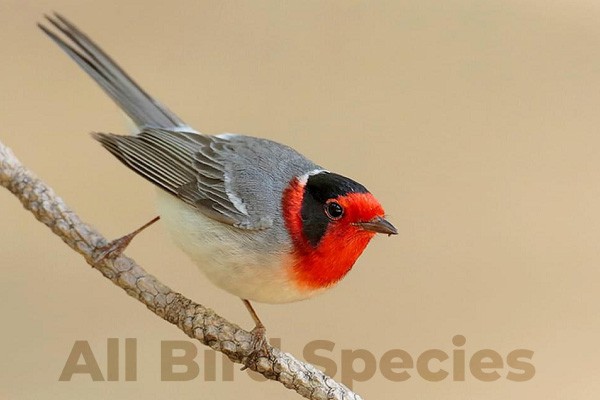
The Red-faced Warbler is a colorful bird species native to the mountains of western North America. It is known for the striking red patch on its back, which adds to its visual appeal. The vibrant red plumage of the Red-faced Warbler makes it an attractive sight for bird enthusiasts and nature lovers.
This small songbird belongs to the family Parulidae and is often spotted in coniferous forests and pine-oak woodlands. The Red-faced Warbler is not only visually captivating but also possesses a beautiful song that adds to its charm.
The red patch on the back of this bird species is a distinct characteristic that sets it apart from other warblers. It serves as a unique identifier, helping birdwatchers and researchers easily recognize and identify the Red-faced Warbler in its natural habitat.
While primarily red on the back, the rest of the Red-faced Warbler’s plumage consists of a combination of gray, black, and white. Males and females showcase similar coloring, although males tend to be slightly more vibrant.
This bird species is known for its acrobatic foraging behavior, often seen hopping along branches or hanging upside down to search for insects and other small invertebrates. It also feeds on berries and seeds, showcasing its versatility in diet.
Due to its specific habitat requirements, the Red-faced Warbler is not commonly found outside its native range. This makes encountering one of these magnificent birds even more special for birdwatchers and enthusiasts.
The Red-faced Warbler is considered to be a migratory bird, spending its breeding season in the mountains of western North America and then wintering in parts of Mexico and Central America.
If you’re a bird lover or simply appreciate the beauty of nature, keep an eye out for the Red-faced Warbler on your next outdoor adventure. Its vibrant red patch on the back and melodious song are sure to captivate and leave a lasting impression.
#8 Downy Woodpecker
The Downy Woodpecker is a small bird with a bright red head. This woodpecker species can be found throughout North America and is known for its drumming behavior.
The Downy Woodpecker (Picoides pubescens), a medium-sized woodpecker, is one of the smallest woodpeckers in North America, measuring only about 6-7 inches in length. It is easily recognized by its diminutive size, white undersides, black wings with white spots, and of course, its striking bright red head.
This small bird can be found in a variety of habitats including forests, woodlands, parks, and even in urban areas with mature trees. It is commonly seen foraging for insects on tree trunks and branches, using its strong bill to peck and probe for food.
The Downy Woodpecker’s drumming behavior is a unique characteristic of this species. The medium-sized woodpecker uses rapid, rhythmic drumming to communicate with other woodpeckers and establish its territory. The sound can be heard from a distance and is often described as a series of short, sharp taps.
Despite its size, the Downy Woodpecker is an agile and acrobatic climber. It can easily move up and down tree trunks and even hang upside down while foraging for insects hidden in the bark.
This woodpecker species is also known to excavate nest cavities in dead trees or branches, using its bill to create a suitable nesting site. It lays a clutch of 3-8 eggs, which are incubated by both parents. Once hatched, the young woodpeckers are fed a diet of insects until they are ready to leave the nest.
Overall, the Downy Woodpecker The pileated woodpecker is a fascinating and charismatic bird species. Its small size, bright red head, and distinctive behavior make it a favorite among birdwatchers and nature enthusiasts alike.
#9 Red-bellied Woodpecker
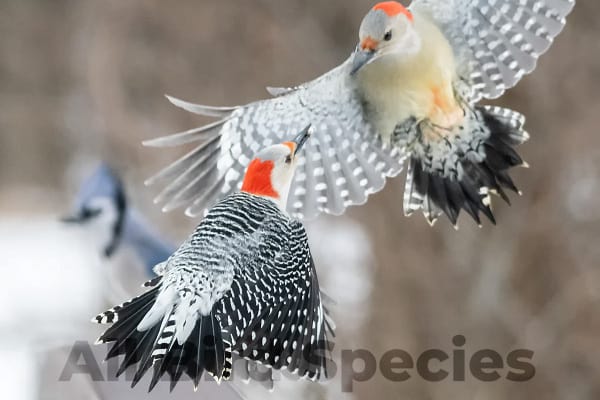
The Red-bellied Woodpecker is a fascinating woodpecker species that can be found all across the United States. What sets this red-headed woodpecker apart is its distinctive red plumage, which is prominently displayed on its head and breast. The vibrant red coloring of the Red-bellied Woodpecker is a sight to behold, capturing the attention of birdwatchers and nature enthusiasts alike.
With its striking appearance, the Red-bellied Woodpecker stands out among other woodpecker species. While its name may suggest a focus on its belly, the red plumage on its head and breast is what truly defines this bird. The contrasting hues of red and black make it easily recognizable, even from a distance.
Besides its red plumage, the Red-bellied Woodpecker is known for its persistent drumming behavior. This woodpecker species creates loud and rhythmic sounds by pecking on trees, resonating throughout the forest. The drumming serves various purposes, including establishing territory and attracting a mate.
The Red-bellied Woodpecker’s distinctive red coloring and unique behavior make it a favorite among bird enthusiasts. Whether you spot one in your backyard or while exploring the outdoors, encountering this beautiful woodpecker species is a memorable experience.
Frequently Asked Questions
Q1: Which bird has a redhead?
The bird with a redhead is the Red-headed Woodpecker.
Q2: What is the name of the bird with a red face?
The bird with a red face is often called the Red-faced Warbler.
Q3: What bird has a red cap?
The bird with a red cap is commonly known as the Red-capped Cardinal.
Q4: What is a small bird with a red spot on its head?
The small bird with a red spot on its head is known as the Ruby-crowned Kinglet.
Q5: What kind of bird is red?
Various birds can have red plumage, including Cardinals, Scarlet Tanagers, and Vermilion Flycatchers.
Q6: What bird has a red head and horn?
The bird with a red head and horn is the Northern Cardinal.

